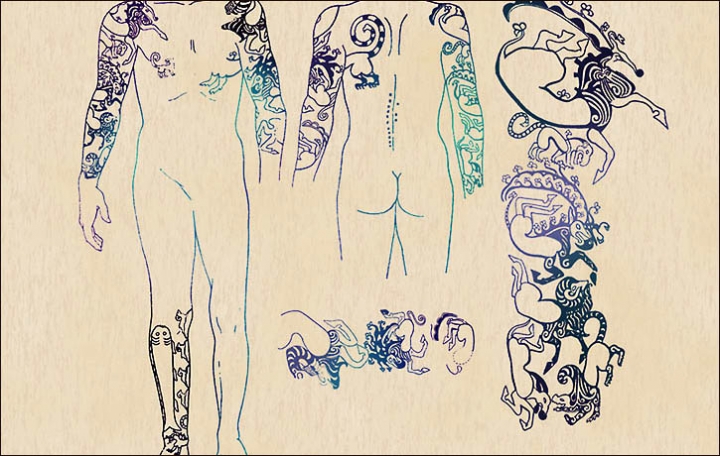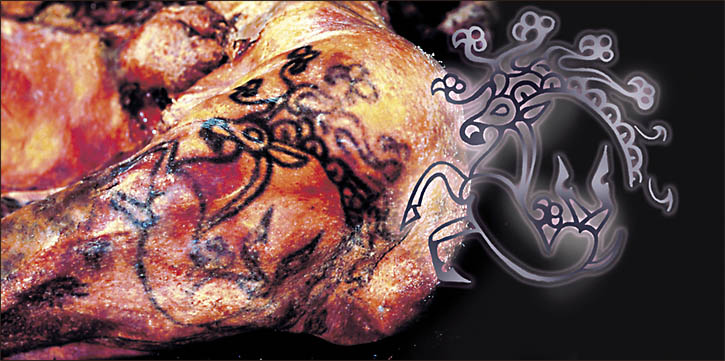Let's go back to 2012 when news of a tattooed Siberian princess made headlines. A brief recap:
The ancient mummy of a mysterious young woman, known as the Ukok Princess, is finally returning home to the Altai Republic this month. She is to be kept in a special mausoleum at the Republican National Museum in capital Gorno-Altaisk, where eventually she will be displayed in a glass sarcophagus to tourists. For the past 19 years, since her discovery, she was kept mainly at a scientific institute in Novosibirsk, apart from a period in Moscow when her remains were treated by the same scientists who preserve the body of Soviet founder Vladimir Lenin.

Archeologists even found items from her 'cosmetics bag', which lay inside her coffin next to her left hip, notably a face brush made from horse hair, and a fragment of an 'eyeliner pencil'. This was made from iron rings, inside which was vivianite, giving a deep blue-green colour on the skin. There was also vivianite powder, derived from an iron phosphate mineral, apparently to be applied to the face. 'Analyses showed that the Pazyryk women knew and used the natural mineral blue colour called vivianite and they also produced quite complicated fat-based facial masks to protect the skin from extreme climates of high mountains.'
Known as Princess Ukok, she will be put on public display in a specially-built glass sarcophagus in Gorno-Altaisk, capital of the republic covering the Altai Mountains. Locals hope her tattooed remains - as well as her possessions including an ancient make-up bag - will become a significant tourist attraction at the Republican National Museum in a spectacular mountain region seeking to attract far more Russian and foreign visitors.
Her ancient tattoo is a showpiece of the glittering opening ceremony for the Sochi Paralympics. The tattoo featured in Sochi was from her left shoulder. It shows a mythological animal, a deer with a griffon's beak and a Capricorn's antlers. The antlers are decorated with the heads of griffons. And the same griffon's head is shown on the back of the animal'.
But local peoples from the Altai Republic, which borders Kazakhstan and Mongolia, have long objected to the fact that her burial mound was disturbed. They were also angered by a decision, after 19 years of academic research into her remains, to put her on display in a glass sarcophagus in a local museum. Ancient beliefs say that the mummy's presence in the burial chamber was 'to bar the entrance to the kingdom of the dead'. By removing this mummy, also known as Oochy-Bala, the elders contend that 'the entrance remains open'. 'Today, we honour the sacred beliefs of our ancestors like three millennia ago,' said one elder. 'We have been burying people according to Scythian traditions. We want respect for our traditions'.
Now Siberian scientists have discerned more about the likely circumstances of her demise, but also of her life, use of cannabis, and why she was regarded as a woman of singular importance to her mountain people. Her use of drugs to cope with the symptoms of her illnesses evidently gave her 'an altered state of mind', leading her kinsmen to the belief that she could communicate with the spirits, the experts believe.
The MRI, conducted in Novosibirsk by eminent academics Andrey Letyagin and Andrey Savelov, showed that the 'princess' suffered from osteomyelitis, an infection of the bone or bone marrow, from childhood or adolescence. 'When she was a little over 20 years old, she became ill with another serious disease - breast cancer. It painfully destroyed her' over perhaps five years, said a summary of the medical findings in 'Science First Hand' journal by archeologist Professor Natalia Polosmak, who first found these remarkable human remains in 1993.

Elders in the region where a tattooed princess was found preserved in permafrost have re-sent a petition to Vladimir Putin demanding she be immediately reinterred. They say that since her removal the area has been hit by a series of natural disasters and insist a reburial would 'stop her anger that caused floods and earthquakes'. Ancient beliefs dictate that her presence in the burial chamber had been to 'bar the entrance to the kingdom of the dead'. Scientists say she lived more than 2,500 years ago, meaning she was alive five centuries before the birth of Christ.
An appeal will be launched after a court this week rejected a demand by the the leader of the Teles ethnic group in the Altai Mountains to order the reburial of the world famous tattooed remains of 'Princess Ukok', dug from her tomb in 1993 by leading Russian archeologists. Akai Kine, leader of the Teles ethnic group and president of the Spiritual Centre of the Turks, Kin Altai, demanded that the 'archeological complex' Ak-Alakha-3, where the mummy was found on the Ukok Plateau, should be recognised as a cultural heritage monument and the remains of the 'ice princess' classified as an integral part of the tomb. The 'integrity' of the burial site should be restored before her 2,500 year old remains should be reburied.
The well-preserved 25 year old woman - who probably died from breast cancer - was dug from her ice-clad tomb in 1993 by Russian archeologists, but this is the first time her remains will be publicly displayed. The move to display the mummy in the Anokhin National Museum in Gorno-Altaisk is seen as controversial, even though the remains in a specially built sarcophagus will be viewed only twice a week for a maximum of three hours on each day to ensure she is not damaged. Earlier museum officials appeared to give assurances she would not be displayed.
 Born in Palermo, Italy, she was reputedly very beautiful, as was her mother, although there are no known portraits of her. A History of Mystery says that she was probably the daughter of Thofania d’Adamo, who was executed in 1633 for killing her husband.
Born in Palermo, Italy, she was reputedly very beautiful, as was her mother, although there are no known portraits of her. A History of Mystery says that she was probably the daughter of Thofania d’Adamo, who was executed in 1633 for killing her husband.


